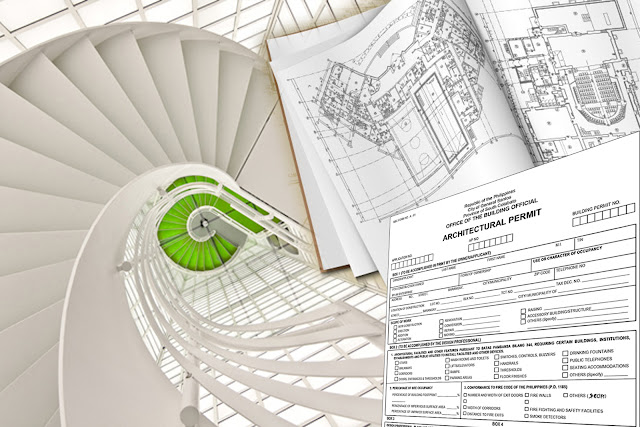 |
| Architectural Documents |
ARCHITECTURAL DOCUMENTS
a.
Architectural Plans/Drawings
i.
Vicinity Map/Location Plan
within a 2.00 kilometer radius for commercial, industrial, and institutional
complex and within a half-kilometer radius for residential buildings, at any
convenient scale showing prominent landmarks or major thoroughfares for easy
reference.
ii.
Site Development Plan showing
technical description, boundaries, orientation and position of proposed
building/structure in relation to the lot, existing or proposed access road and
driveways and existing public utilities/services. Existing buildings within and adjoining the
lot shall be hatched and distances between the proposed and existing buildings
shall be indicated.
iii.
Perspective drawn at a
convenient scale and taken from a vantage point (bird’s eye view or eye level).
iv.
Floor Plans drawn to scale of
not less than 1:100 showing: gridlines, complete identification of rooms or
functional spaces.
v.
Elevations, at least four (4),
same scale as floor plans showing: gridlines; natural ground to finish grade
elevations; floor to floor heights; door and window marks, type of material and
exterior finishes; adjoining existing structure/s, if any, shown in single
hatched lines.
vi.
Sections, at least two (2),
showing: gridlines; natural ground and finish levels; outline of cut and
visible structural parts; doors and windows properly labeled reflecting the
direction of opening; partitions; built-in cabinets, etc.; identification of
rooms and functional spaces cut by section lines.
vii.
Reflected ceiling plan showing:
design, location, finishes and specifications of materials, lighting fixtures,
diffusers, decorations, air conditioning exhaust and return grills, sprinkler
nozzles, if any, at scale of at least 1:100.
viii. Details, in the
form of plans, elevations/sections
(a)
Accessible ramps
(b)
Accessible stairs
(c)
Accessible lifts/elevators
(d)
Accessible entrances, corridors and walkways
(e)
Accessible functional areas/comfort rooms
(f)
Accessible switches, controls
(g)
Accessible drinking fountains
(h)
Accessible public telephone booths
(i)
Accessible audio visual and automatic alarm system
(j)
Accessible access symbols and directional signs
(k)
Reserved parking for disabled persons
(l)
Typical wall/bay sections from ground to roof
(m)
Stairs, interior and exterior
(n)
Fire escapes/exits
(o)
Built-in cabinets, counters and fixed furniture
(p)
All types of partitions
ix.
Schedule of Doors and Windows
showing their types, designations/marks, dimensions, materials, and number of
sets.
x.
Schedule of Finishes, showing
in graphic form: surface finishes specified for floors, ceilings, walls and
baseboard trims for all building spaces per floor level.
xi.
Details of other major
Architectural Elements.
b.
Architectural
Interiors/Interior Design
i.
Space Plan/s or layout/s of
architectural interior/s.
ii.
Architectural interior perspective/s.
iii.
Furniture/furnishing/equipment/process
layout/s.
iv.
Access plan/s, parking plan/s and the like.
v.
Detail design of major architectural interior
elements.
vi.
Plan and layout of interior, wall partitions,
furnishing, furniture, equipment/appliances at a scale of at least 1:100.
vii.
Interior wall elevations showing: finishes,
switches, doors and convenience outlets, cross window sections with interior
perspective as viewed from the main entrance at scale of at least 1:100.
viii. Floor/ceiling/wall
patterns and finishing details.
ix.
List of materials used.
x.
Cost Estimates.
c.
Plans and specific locations of all
accessibility facilities of scale of at least 1:100.
d.
Detailed design of all such accessibility facilities
outside and around buildings/structures including parking areas, and their
safety requirements all at scale of 1:50 or any convenient scale.
e.
Fire Safety Documents
i.
Layout plan of each floor indicating the fire
evacuation route to safe dispersal areas, standpipes with fire hose, fire
extinguishers, first aid kits/cabinets, fire alarm, fire operations room,
emergency lights, signs, etc.
ii.
Details of windows, fire exits with grilled windows
and ladders.
iii.
Details of fire-resistive construction of enclosures
for vertical openings.
iv.
Details of fire-resistive construction materials and
interior decorative materials with fire-resistive/fire-retardant/fire-spread
ratings.
v.
Other Related Documents
f. Other Related Documents
(Source: Rule III Section 302, Sub-section 4 of NBCP)









